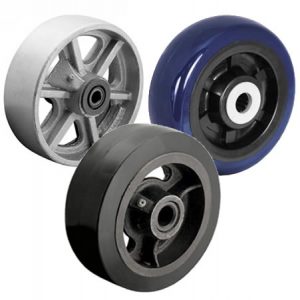
You may be asking yourself, “What is a caster?”, is it just an industry term? The terms “wheels” and “casters” are often used interchangeably to describe rolling devices leading to many people assuming they are the same thing. While wheels and casters are both rolling devices, they differ in several ways. To learn more about wheels and casters, including how they differ, keep reading.
What Are Wheels?
Wheels are round objects that are designed to roll when exposed to a force. Along with levers, wedges, axels and pulleys, they are classified as a simple machine. Wheels, of course, have been around for a long time. While it’s unknown when they were invented, historians have found evidence of wheels dating back to 4500 BC. Wheels are available in different materials. Some of them are mate rubber, whereas others are made of polyurethane (PU).
What Are Casters?
Casters, on the other hand, are wheeled rolling devices that are designed for use with another object. You can find them on industrial machines, office chairs, grocery carts, hand trucks and more. Casters typically consist of a wheel within a metal frame. They are installed using fasteners that connect the frame to a given object. All casters have a wheel. The wheel is placed inside of a metal frame where it’s able to roll when exposed to a force.
Some of the most common types of casters include the following:
- Rigid casters
- Swivel casters
- Medical casters
- Leveling Casters
- Rotacasters
- Industrial casters
Differences Between Wheels and Casters
Wheels and casters aren’t the same. Wheels are more basic than casters. As previously mentioned, they consist of a round object, which is able to roll when exposed to a force. Casters are more complex. They feature a wheel as well, but casters have a metal frame that allows them to be used in conjunction with another object.
Because they contain a metal frame, casters are also available in more types than traditional wheels. There are swiveling casters, for instance, that live up to their namesake by supporting swiveling movements. They don’t just roll back and forth. Rather, swiveling casters can swivel from side to side.
Casters are easier to install than wheels. You can’t just screw or otherwise fasten a wheel to an object. Instead, you’ll need to use a frame, which is where casters come into play. All casters have a frame — typically made of stainless steel or aluminum — that houses a wheel. With this metal frame, you can easily install them on objects.
